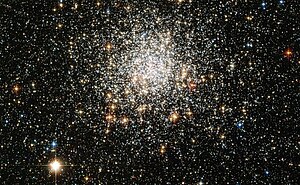| NGC 1806 | |
|---|---|
 NGC 1806 image taken by the Hubble Space Telescope | |
| Observation data (J2000 epoch) | |
| Class | VI[1] |
| Constellation | Dorado |
| Right ascension | 05h 02m 11.180s[2] |
| Declination | −67° 59′ 05.89″[2] |
| Apparent magnitude (V) | 11.00[3] |
| Physical characteristics | |
| Mass | 7.6×104[3] M☉ |
| Estimated age | 1.60±0.05 Gyr[3] |
| Other designations | NGC 1806, KMHK 462, [SL63] 184 |
NGC 1806 is a globular cluster located within the Large Magellanic Cloud within the constellation of Dorado (the dolphin-fish), an area of the sky best seen from the Earth's southern hemisphere. It was discovered in 1836 by the British astronomer John Herschel. At an aperture of 50 arcseconds, its apparent V-band magnitude is 11.00, but at this wavelength, it has 0.05 magnitudes of interstellar extinction.[3]
NGC 1806 is about 1.6 billion years old. Its estimated mass is 7.6×104 M☉, and its total luminosity is 1.42×105 L☉, leading to a mass-to-luminosity ratio of 0.54 M☉/L☉.[3] All else equal, older star clusters have higher mass-to-luminosity ratios; that is, they have lower luminosities for the same mass.[3]
- ^ Cite error: The named reference
hcob849_11was invoked but never defined (see the help page). - ^ a b "NGC 1806". SIMBAD. Centre de données astronomiques de Strasbourg. Retrieved 8 January 2019.
- ^ a b c d e f Song, Ying-Yi; Mateo, Mario; Bailey, John I.; Walker, Matthew G.; Roederer, Ian U.; Olszewski, Edward W.; Reiter, Megan; Kremin, Anthony (2021). "Dynamical masses and mass-to-light ratios of resolved massive star clusters – II. Results for 26 star clusters in the Magellanic Clouds". Monthly Notices of the Royal Astronomical Society. 504 (3): 4160–4191. arXiv:2104.06882. doi:10.1093/mnras/stab1065.